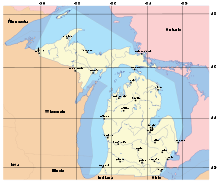
Michigan consists of two peninsulas surrounded primarily by four of the Great Lakes and a variety of nearby islands. The Upper Peninsula is bounded on the southwest by Wisconsin, and the Lower Peninsula is bounded on the south by Indiana and Ohio. Both land masses are also separated from the Canadian province of Ontario by waterways of the Great Lakes, and from each other by the Straits of Mackinac. Because its land is largely surrounded by the Great Lakes, which flow into the Saint Lawrence River, Michigan is the only U.S. state whose streams and rivers are almost entirely within the Great Lakes-St. Lawrence watershed.
Michigan's territorial waters include roughly half each of Lake Superior, Lake Michigan, and Lake Huron, and smaller areas of Lake St. Clair and Lake Erie. It includes an estimated 11,000 inland lakes.[1] It encompasses 58,110 square miles (150,500 km2) of land, 38,575 square miles (99,910 km2) of Great Lakes waters, and 1,305 square miles (3,380 km2) of inland waters. Its territorial waters are second in area only to those of Alaska.[2] At a total area of 97,990 square miles (253,800 km2) – including those territorial waters – Michigan is the largest state east of the Mississippi River, and the eleventh largest state overall. More than half of the state's land area – 30,156 square miles (78,100 km2) – is still forest.
The state lies roughly between 41° and 49° north latitude, and between 82° and 91° west longitude.
- ^ "FAQ". Michigan Inland Lakes Partnership. Retrieved 2020-03-05.
- ^ "Land and Water Area of States, 2000".